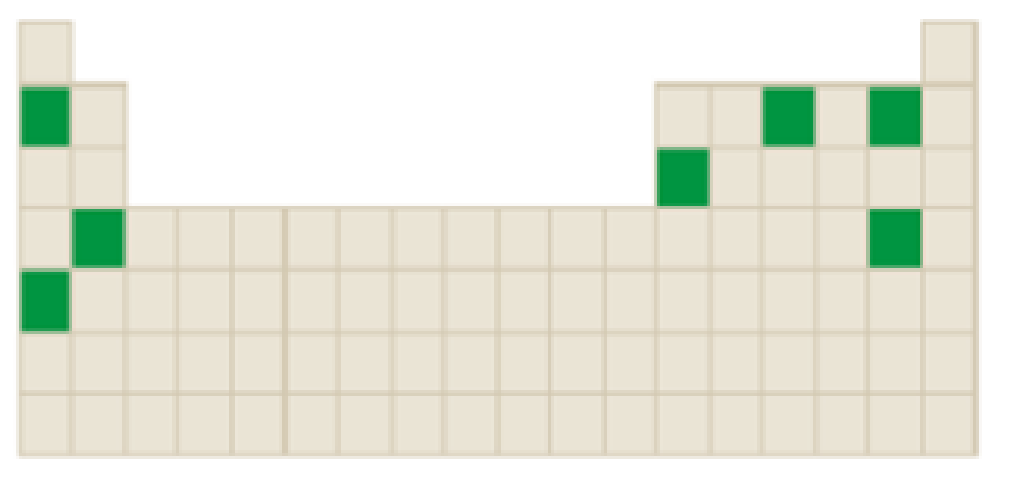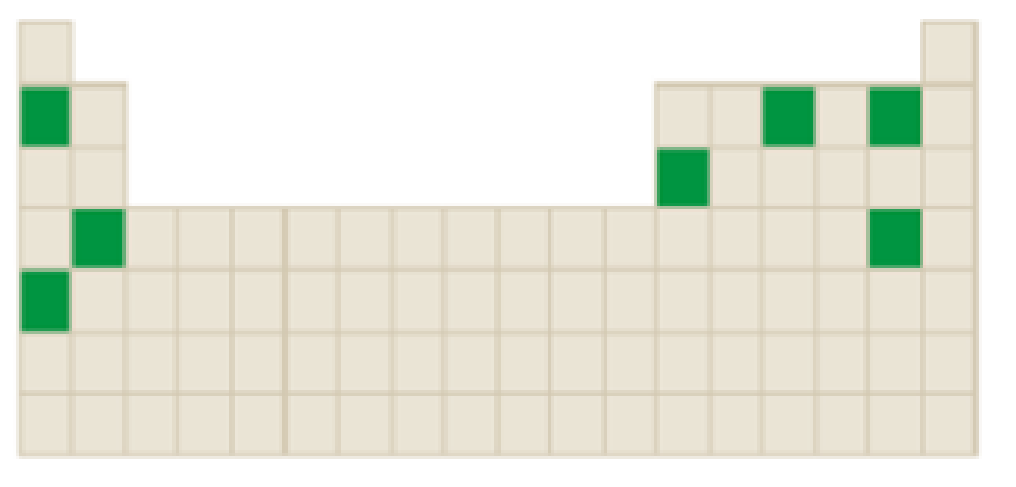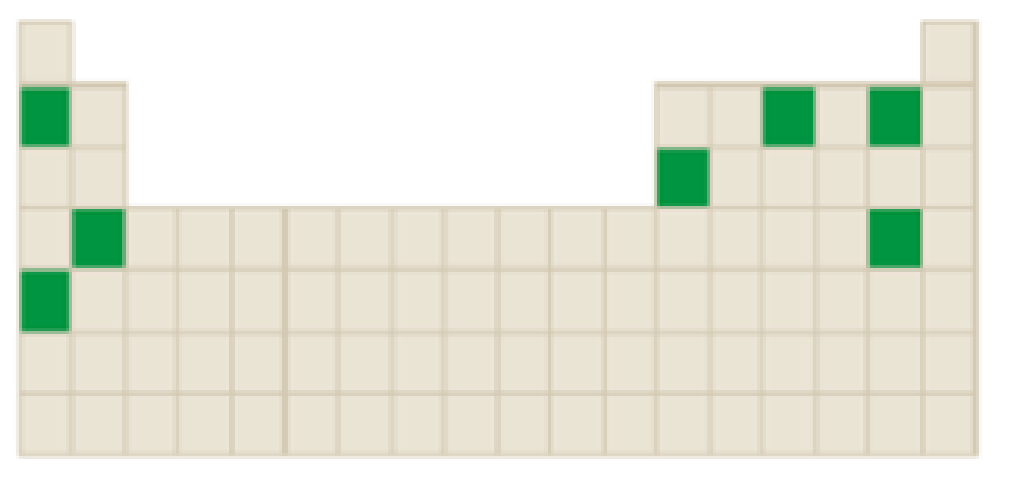
(a)
Interpretation:
Identification of the number of elements forms a positively charged ions among the following highlighted elements in the below periodic table:

Concept Introduction:
Atoms tend to gain or lose electrons until they obtain an electron configuration that is the same as that of a noble gas.
The neutral atom has equal number of protons and electrons. Gaining or loosing of a electrons of an atoms form ions.
Atoms form their ions to attain noble gas configuration.
- Group IA, IIA and IIIA are metal atoms containing one, two or three valence electrons. These metal atoms lose their valence electrons to get noble gas configuration.
- Group VA, VIA VIIA are non-metal atoms containing five, six or seven valence electrons. These non-metal atoms acquire electrons to get noble gas configuration.
- Group IVA group elements have four valence electrons. These elements either gain or lose their electrons to get noble gas configuration.
(b)
Interpretation:
Identification of the element forms ions through loss of electrons among the following highlighted elements in the below periodic table:

Concept Introduction:
Atoms tend to gain or lose electrons until they obtain an electron configuration that is the same as that of a noble gas.
The neutral atom has equal number of protons and electrons. Gaining or loosing of a electrons of an atoms form ions.
Atoms form their ions to attain noble gas configuration.
- Group IA, IIA and IIIA are metal atoms containing one, two or three valence electrons. These metal atoms lose their valence electrons to get noble gas configuration.
- Group VA, VIA VIIA are non-metal atoms containing five, six or seven valence electrons. These non-metal atoms acquire electrons to get noble gas configuration.
- Group IVA group elements have four valence electrons. These elements either gain or lose their electrons to get noble gas configuration.
(c)
Interpretation:
Identification of the elements which forms ion that has a charge magnitude of

Concept Introduction:
Atoms tend to gain or lose electrons until they obtain an electron configuration that is the same as that of a noble gas.
The neutral atom has equal number of protons and electrons. Gaining or loosing of a electrons of an atoms form ions.
Atoms form their ions to attain noble gas configuration.
- Group IA, IIA and IIIA are metal atoms containing one, two or three valence electrons. These metal atoms lose their valence electrons to get noble gas configuration.
- Group VA, VIA VIIA are non-metal atoms containing five, six or seven valence electrons. These non-metal atoms acquire electrons to get noble gas configuration.
- Group IVA group elements have four valence electrons. These elements either gain or lose their electrons to get noble gas configuration.
(d)
Interpretation:
Identification of the element forms an ion that involves gain of two or more electrons among the following highlighted elements in the below periodic table:

Concept Introduction:
Atoms tend to gain or lose electrons until they obtain an electron configuration that is the same as that of a noble gas.
The neutral atom has equal number of protons and electrons. Gaining or loosing of a electrons of an atoms form ions.
Atoms form their ions to attain noble gas configuration.
- Group IA, IIA and IIIA are metal atoms containing one, two or three valence electrons. These metal atoms lose their valence electrons to get noble gas configuration.
- Group VA, VIA VIIA are non-metal atoms containing five, six or seven valence electrons. These non-metal atoms acquire electrons to get noble gas configuration.
- Group IVA group elements have four valence electrons. These elements either gain or lose their electrons to get noble gas configuration.
Want to see the full answer?
Check out a sample textbook solution
Chapter 4 Solutions
Bundle: General, Organic, and Biological Chemistry, 7th + OWLv2 Quick Prep for General Chemistry, 4 terms (24 months) Printed Access Card
- Predict the major products of this organic reaction: H OH 1. LiAlH4 2. H₂O ? Note: be sure you use dash and wedge bonds when necessary, for example to distinguish between major products with different stereochemistry. Click and drag to start drawing a structure. G C टेarrow_forwardFor each reaction below, decide if the first stable organic product that forms in solution will create a new C-C bond, and check the appropriate box. Next, for each reaction to which you answered "Yes" to in the table, draw this product in the drawing area below. Note for advanced students: for this problem, don't worry if you think this product will continue to react under the current conditions - just focus on the first stable product you expect to form in solution. NH2 CI MgCl ? Will the first product that forms in this reaction create a new CC bond? Yes No MgBr ? Will the first product that forms in this reaction create a new CC bond? Yes No G टेarrow_forwardFor each reaction below, decide if the first stable organic product that forms in solution will create a new CC bond, and check the appropriate box. Next, for each reaction to which you answered "Yes" to in the table, draw this product in the drawing area below. Note for advanced students: for this problem, don't worry if you think this product will continue to react under the current conditions - just focus on the first stable product you expect to form in solution. དྲ。 ✗MgBr ? O CI Will the first product that forms in this reaction create a new C-C bond? Yes No • ? Will the first product that forms in this reaction create a new CC bond? Yes No × : ☐ Xarrow_forward
- Predict the major products of this organic reaction: OH NaBH4 H ? CH3OH Note: be sure you use dash and wedge bonds when necessary, for example to distinguish between major products with different stereochemistry. Click and drag to start drawing a structure. ☐ : Sarrow_forwardPredict the major products of this organic reaction: 1. LIAIHA 2. H₂O ? Note: be sure you use dash and wedge bonds when necessary, for example to distinguish between major products with different stereochemistry. Click and drag to start drawing a structure. X : ☐arrow_forwardFor each reaction below, decide if the first stable organic product that forms in solution will create a new C - C bond, and check the appropriate box. Next, for each reaction to which you answered "Yes" to in the table, draw this product in the drawing area below. Note for advanced students: for this problem, don't worry if you think this product will continue to react under the current conditions - just focus on the first stable product you expect to form in solution. NH2 tu ? ? OH Will the first product that forms in this reaction create a new CC bond? Yes No Will the first product that forms in this reaction create a new CC bond? Yes No C $ ©arrow_forward
- As the lead product manager at OrganometALEKS Industries, you are trying to decide if the following reaction will make a molecule with a new C-C bond as its major product: 1. MgCl ? 2. H₂O* If this reaction will work, draw the major organic product or products you would expect in the drawing area below. If there's more than one major product, you can draw them in any arrangement you like. Be sure you use wedge and dash bonds if necessary, for example to distinguish between major products with different stereochemistry. If the major products of this reaction won't have a new CC bond, just check the box under the drawing area and leave it blank. Click and drag to start drawing a structure. This reaction will not make a product with a new CC bond. G marrow_forwardIncluding activity coefficients, find [Hg22+] in saturated Hg2Br2 in 0.00100 M NH4 Ksp Hg2Br2 = 5.6×10-23.arrow_forwardgive example for the following(by equation) a. Converting a water insoluble compound to a soluble one. b. Diazotization reaction form diazonium salt c. coupling reaction of a diazonium salt d. indacator properties of MO e. Diazotization ( diazonium salt of bromobenzene)arrow_forward
- 2-Propanone and ethyllithium are mixed and subsequently acid hydrolyzed. Draw and name the structures of the products.arrow_forward(Methanesulfinyl)methane is reacted with NaH, and then with acetophenone. Draw and name the structures of the products.arrow_forward3-Oxo-butanenitrile and (E)-2-butenal are mixed with sodium ethoxide in ethanol. Draw and name the structures of the products.arrow_forward
 World of Chemistry, 3rd editionChemistryISBN:9781133109655Author:Steven S. Zumdahl, Susan L. Zumdahl, Donald J. DeCostePublisher:Brooks / Cole / Cengage Learning
World of Chemistry, 3rd editionChemistryISBN:9781133109655Author:Steven S. Zumdahl, Susan L. Zumdahl, Donald J. DeCostePublisher:Brooks / Cole / Cengage Learning Introductory Chemistry: A FoundationChemistryISBN:9781337399425Author:Steven S. Zumdahl, Donald J. DeCostePublisher:Cengage Learning
Introductory Chemistry: A FoundationChemistryISBN:9781337399425Author:Steven S. Zumdahl, Donald J. DeCostePublisher:Cengage Learning General, Organic, and Biological ChemistryChemistryISBN:9781285853918Author:H. Stephen StokerPublisher:Cengage Learning
General, Organic, and Biological ChemistryChemistryISBN:9781285853918Author:H. Stephen StokerPublisher:Cengage Learning
 Chemistry for Today: General, Organic, and Bioche...ChemistryISBN:9781305960060Author:Spencer L. Seager, Michael R. Slabaugh, Maren S. HansenPublisher:Cengage Learning
Chemistry for Today: General, Organic, and Bioche...ChemistryISBN:9781305960060Author:Spencer L. Seager, Michael R. Slabaugh, Maren S. HansenPublisher:Cengage Learning Introductory Chemistry: An Active Learning Approa...ChemistryISBN:9781305079250Author:Mark S. Cracolice, Ed PetersPublisher:Cengage Learning
Introductory Chemistry: An Active Learning Approa...ChemistryISBN:9781305079250Author:Mark S. Cracolice, Ed PetersPublisher:Cengage Learning





